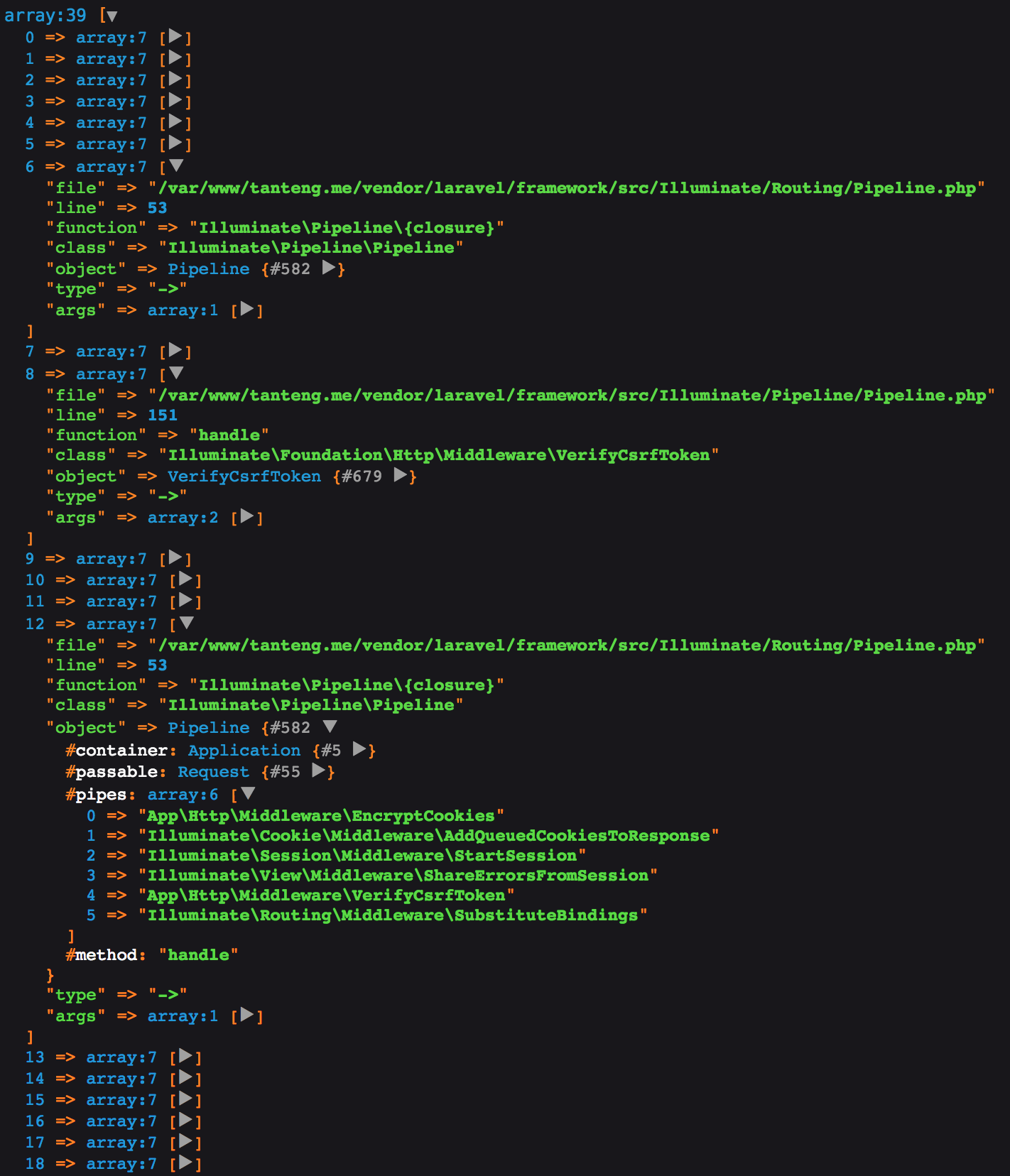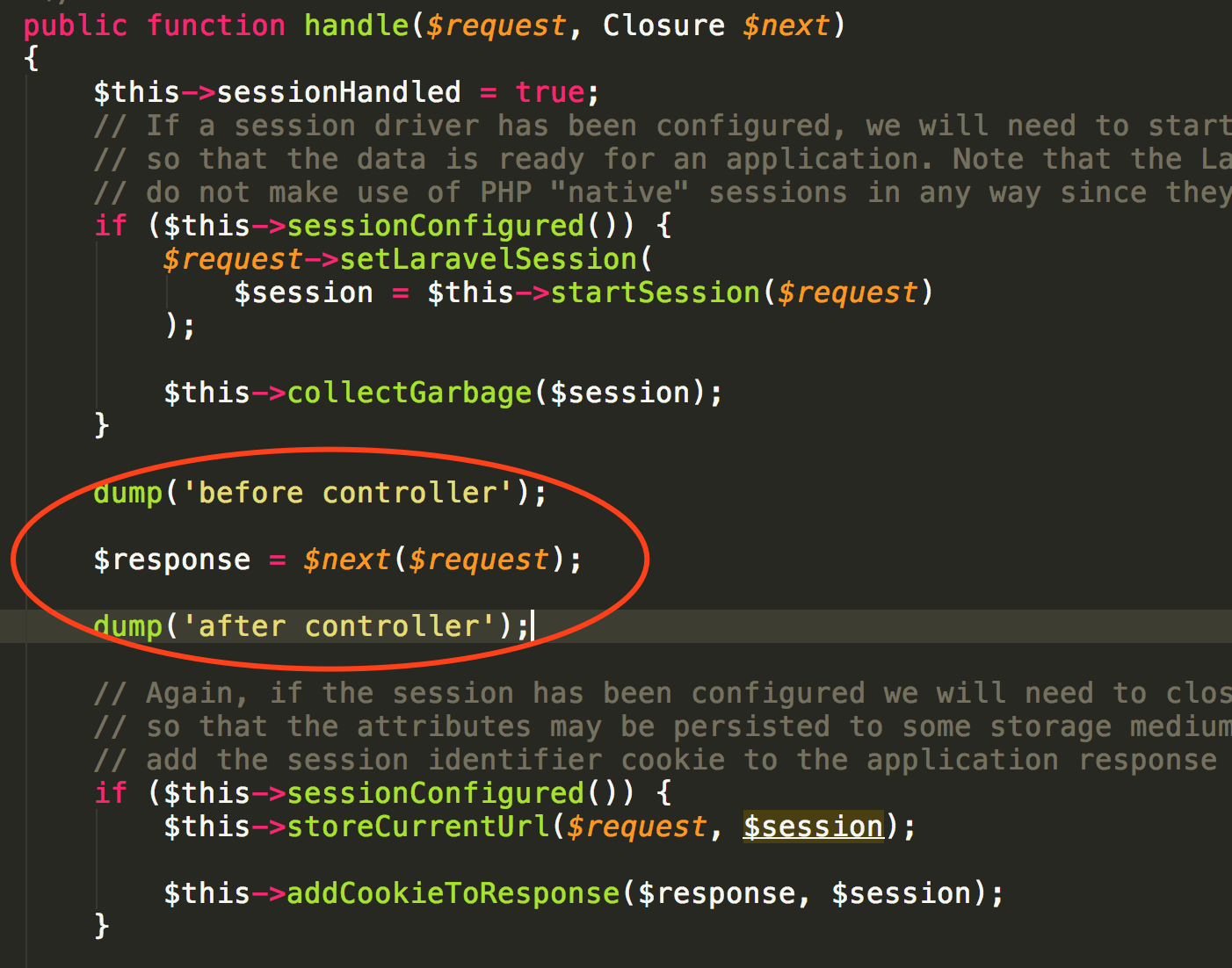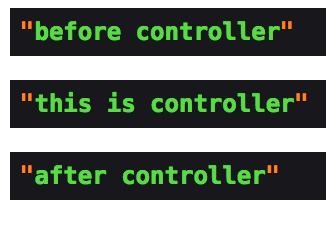Laravel 的中间件机制提供了一种管道的方式,每个 HTTP 请求经过一个又一个中间件进行过滤,Laravel 内置了很多中间件,比如 CSRF 机制,身份认证,Cookie 加密,设置 Cookie 等等。
本文就来探究 Laravel 中间件的实现原理,看 Laravel 如何把 PHP 的 array_reduce 函数和闭包用到了极致。
需要先了解 Laravel 中间件的用法,如何定义一个中间件,还有前置中间件,后置中间件的概念。(文档: Laravel 5.5 中间件 )开始
为了彻底弄懂 Laravel 中间件原理,可以构造一个路由,并使用 debug_backtrace 函数来打印方法调用过程。Route::get('test',function(){
dump(debug_backtrace());
});
如图,可见许多地方都跟 Pipeline 组件有关,并且重复执行一个闭包方法。

这里 pipes 数组就是需要用到的中间件。中间件核心类 Pipeline
在 Laravel 框架 index.php 入口文件里,$kernel->handle() 方法就调用了 Pipeline 的方法,可以说它是贯穿始终的,这是把请求发到中间件进行处理的方法:/**
* Send the given request through the middleware / router.
*
* @param IlluminateHttpRequest $request
* @return IlluminateHttpResponse
*/
protected function sendRequestThroughRouter($request)
{
$this->app->instance('request', $request);
Facade::clearResolvedInstance('request');
$this->bootstrap();
return (new Pipeline($this->app))
->send($request)
->through($this->app->shouldSkipMiddleware() ? [] : $this->middleware)
->then($this->dispatchToRouter());
}
其中 send 方法是设置 passable 属性也就是 $request,through 是设置 pipes 属性,也就是需要用到的中间件,是一个数组,重点是这里的 then 方法,参数也是一个闭包函数。/**
* Run the pipeline with a final destination callback.
*
* @param Closure $destination
* @return mixed
*/
public function then(Closure $destination)
{
$pipeline = array_reduce(
array_reverse($this->pipes), $this->carry(), $this->prepareDestination($destination)
);
return $pipeline($this->passable);
}ARRAY_REDUCE 使用
这里就需要讲解一下 array_reduce 的用法了,可以说是妙用,这是理解 Laravel 中间件的重点,深刻领会了它的用法,就弄懂了 Laravel 中间件的原理。
先看一个官方例子明白它的基本用法:function sum($carry, $item)
{
$carry += $item;
return $carry;
}
$a = array(1, 2, 3, 4, 5);
var_dump(array_reduce($a, "sum")); // int(15)
基础用法参考 PHP 文档: array_reduce
这是一个最简单的例子,array_reduce 会迭代每个元素,回调函数第一个参数是上次执行的结果,然后返回最终的一个值。
那么第二个参数的回调函数返回的是一个闭包呢?$arr = ['AAAA', 'BBBB', 'CCCC'];
$res = array_reduce($arr, function($carry, $item){
return function() use ($carry,$item){
dump("item:".$item);
if(is_null($carry)){
return "CARRY is null. item:".$item;
}
if($carry instanceof Closure){
dump($carry());
return strtolower($item);
}
return $item;
};
});
dump($res());
这个例子第二个参数回调函数返回的是一个闭包,也就是说 array_reduce 函数最终返回的也是一个闭包,除非执行这个闭包,否则里面的逻辑不会执行,这也是闭包的神奇之处,我们可以把函数“暂存”起来以后执行。
第一次迭代,$carry 是空的,返回一个字符串。
第二次迭代,因为第一次返回了一个闭包,所以这次 $carry 是一个闭包,返回小写字母。
第三次迭代,因为第二次迭代返回的是一个闭包,所以也是返回一个小写字母。
这个闭包的执行结果是:
“item:CCCC”
“ item:BBBB ”
“ item:AAAA ”
“ CARRY is null. item:AAAA ”
“ bbbb ”
“
cccc
“
一定要弄懂为什么这样输出,它的执行顺序是反的,可以理解为每一次迭代,就是把闭包函数丢到一个栈里面,后进先出。实现的核心
接下来要分析 $this->carry() 这个方法,它是中间件实现的核心。/**
* Get a Closure that represents a slice of the application onion.
*
* @return Closure
*/
protected function carry()
{
return function ($stack, $pipe) {
return function ($passable) use ($stack, $pipe) {
if (is_callable($pipe)) {
// If the pipe is an instance of a Closure, we will just call it directly but
// otherwise we'll resolve the pipes out of the container and call it with
// the appropriate method and arguments, returning the results back out.
return $pipe($passable, $stack);
} elseif (! is_object($pipe)) {
list($name, $parameters) = $this->parsePipeString($pipe);
// If the pipe is a string we will parse the string and resolve the class out
// of the dependency injection container. We can then build a callable and
// execute the pipe function giving in the parameters that are required.
$pipe = $this->getContainer()->make($name);
$parameters = array_merge([$passable, $stack], $parameters);
} else {
// If the pipe is already an object we'll just make a callable and pass it to
// the pipe as-is. There is no need to do any extra parsing and formatting
// since the object we're given was already a fully instantiated object.
$parameters = [$passable, $stack];
}
return method_exists($pipe, $this->method)
? $pipe->{$this->method}(...$parameters)
: $pipe(...$parameters);
};
};
}
这个 carry 方法返回一个闭包(或者说函数也可以),作为 array_reduce 的第二个参数作为回调函数。这个方法看上去很复杂,闭包里面返回闭包,但是搞清楚了之后就没这么难。
这个作为 array_reduce 的回调函数的闭包,接受两个参数,第一个参数也是个闭包,而且第一次迭代的闭包是另外一个方法提供的,第二个参数是中间件,是一个字符串形式。
第一次迭代,$stack 参数是 $this->dispatchToRouter() 返回的闭包,实际上放到最后执行了,$pipe 参数是 IlluminateRoutingMiddlewareSubstituteBindings,(注意 array_reverse 把 pipes 数组反转了,实际上理解了原理就知道这样做反而是要按中间件定义的顺序执行),那么根据判断逻辑,从容器中取出中间件,最后执行中间件的 handle 方法,并传入 $request 和 $stack 作为参数, 但实际上并没有任何实际的执行,注意这个函数返回的也是一个闭包。
第二次迭代,还是执行这个回调函数,此时 $stack 就变成了第一次也就是上次迭代返回的闭包了,第二个参数 $pipe 就是 AppHttpMiddlewareVerifyCsrfToken,其他过程同上,也返回一个闭包。
……
最后一次迭代,$stack 是上一次返回的闭包,$pipe 就是 AppHttpMiddlewareEncryptCookies,但到此没有任何实际的执行,因为没有调用。
这些闭包,可以理解为放到一个“栈”里面了,执行的时候从最外层开始往里面执行,后进先出。
最后,then 方法里 return $pipeline($this->passable) 才是调用 array_reduce 返回的最终的闭包,开始真正执行这些中间件了。前置和后置中间件
我们把控制器方法改成:Route::get('test',function(){
dump('this is controller');
//dump(debug_backtrace());
});
然后随便找一个中间件在 $response = $next($request) 前后打印点内容:

执行,页面上的输出如图:

这是为什么呢?$response = $next($request);
这里 $next 就是前文中的 $stack,执行这句的时候就会把所有中间件都执行完,然后别忘了前面说的第一个闭包是 $this->dispatchToRouter() 提供的,它会进入到控制器逻辑,然后再是执行每个中间件中 $response = $next($request) 接下来的逻辑。这也是前置中间件和后置中间件的原理。
要彻底弄懂 Laravel 中间件原理,还需要亲自熟悉 array_reduce 方法和理解闭包的概念。
来源:小谈博客(https://blog.tanteng.me/2018/0 ... ware/)




















 341
341











 被折叠的 条评论
为什么被折叠?
被折叠的 条评论
为什么被折叠?








